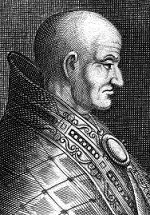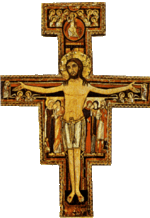Pope Sergius III
| Sergius III | |
|---|---|
 |
|
| Papacy began | 29 January 904 |
| Papacy ended | 14 April 911 |
| Predecessor | Leo V |
| Successor | Anastasius III |
| Personal details | |
| Birth name | Sergius |
| Born | ??? Rome, Italy |
| Died | 14 April 911 Rome, Italy |
| Other Popes named Sergius | |
Sergius III was a pope of the Roman Catholic Church from 29 January 904 to 14 April 911. Because Sergius III was possibly the only pope known to have ordered the murder of another pope and the only pope thought to have fathered an illegitimate son who later became pope (John XI), his pontificate has been described as "dismal and disgraceful."[1]
Sergius was the son of Benedictus, and came from a noble Roman family. His tenure was part of a period of feudal violence and disorder in central Italy, when the Papacy was a pawn of warring aristocratic factions.
The pontificate of Sergius III, according to Liutprand of Cremona, was remarkable for the rise of what papal historians saw as a "pornocracy", or "rule of the harlots", a reversal of the natural order as they saw it, according to Liber pontificalis and a later chronicler who was also biased against Sergius III. This "pornocracy" was an age with women in power: Theodora, whom Liutprand characterized as a "shameless whore... [who] exercised power on the Roman citizenry like a man" and her daughter Marozia, the mother of Pope John XI (931–935) and reputed to be the mistress of Sergius III, largely upon a remark by Liutprand (see Brook link below).
Sergius III owed his rise to the power of his patron, the military commander Theophylact, Count of Tusculum, who held the position of vestarius, the official at the top of papal patronage in control of the disbursements, and thus of patronage. Sergius III and his party opposed Pope Formosus (891–896), who ordained him bishop of Caere (Cerveteri) in order to remove him from Rome, as an unsympathetic source records. He was his faction's unsuccessful candidate for the papacy in 896. When Pope John IX (898–900) was elected instead, he excommunicated Sergius, who had to withdraw from his see at Cerveteri for safety. Elected pope in 897, Sergius III was forcibly exiled by Lambert, duke of Spoleto, and all the official records were destroyed; consequently, most of the surviving documentation about Sergius comes from his opponents.
When Antipope Christopher (903–904) seized the seat of St. Peter by force, the Theophylact faction of Romans revolted and ejected him in 903–904. They then invited Sergius III to come out of retirement. His return is marked as 29 January 904.
Back in power, Sergius III now annulled all the ordinations of Formosus and demanded all bishops ordained by Formosus be reordained, an unwelcome decision reversed again after his death. Sergius honoured Pope Stephen VI (896–897), who had been responsible for the "Cadaver Synod" that had condemned and mutilated the corpse of Pope Formosus, and placed a laudatory remark on Stephen VI's tombstone. He then reportedly had the much-abused corpse of Formosus exhumed once more, tried, found guilty again, and beheaded, thus in effect conducting a second Cadaver Synod:[2] although Joseph Brusher, S.J. says that "Sergius [III] indulged in no resurrection-man tactics himself"[3] and Schaff, Milman,[4] Gregorovius,[5] von Mosheim,[6] Miley,[7] Mann,[8] Darras,[9] John the Deacon of Naples, Flodoard, and others make no mention of this story.
His nemeses, Pope Leo V (903) and Antipope Christopher, both died in 904, allegedly strangled in prison on the order of Sergius,[10] a claim that the Catholic Encyclopedia called "extremely doubtful."
Sergius III restored the Lateran Palace, which had been shattered by an earthquake in 896. He is the first pope to be depicted wearing the triple-crowned papal tiara.
References
- ↑ Wilkes. 2001, October 31. ""The Cadaver Synod: The Strangest Trial in History" Flagpole Magazine. p. 8.
- ↑ "Nor was he [Sergius III] content with thus dishonouring the dead Pope [Formosus], but he drags his carcass again out of the grave, beheads it as if it had been alive, and then throws it into the Tiber, as unworthy the honour of human burial." Platina, Bartolomeo, The Lives of the Popes From The Time Of Our Saviour Jesus Christ to the Accession of Gregory VII, I, London: Griffith Farran & Co., pp. 243, http://www.archive.org/details/thelivesofthepop01platuoft, retrieved 2008-01-08.
- ↑ Brusher, Joseph (1959), "Sergius III", Popes Through the Ages (Neff-Kane), http://cfpeople.org/Books/Pope/POPEp120.htm#T1, retrieved 2008-01-02
- ↑ Milman, Henry Hart (1867), History of Latin Christianity, III (4th ed.), London: John Murray, pp. 287–290.
- ↑ Gregorovius, Ferdinand (1903), The History of the City of Rome in the Middle Ages, III (2nd ed.), London: George Bell & Sons, pp. 242–248, http://books.google.com/?id=tLk4AAAAIAAJ&printsec=titlepage, retrieved 2008-01-08.
- ↑ von Mosheim, Johann Lorenz (1852), Institutes of Ecclesiastical History, Ancient and Modern, II (5th ed.), New York: Stanford and Swords, pp. 120–121, http://books.google.com/?id=RxEQAAAAYAAJ&printsec=titlepage, retrieved 2008-01-08.
- ↑ Miley, John (1850), The History of the Papal States From Their Origin to the Present Day, II, London: T.C. Newby, pp. 269–281, http://books.google.com/?id=mrsLAAAAYAAJ&printsec=titlepage, retrieved 2008-01-08.
- ↑ Mann, Horace Kinder (1910), The Lives of the Popes In The Early Middle Ages, IV, London: Kegan Paul, Trench, Trübner, & Co., Ltd., pp. 119–142, http://www.archive.org/details/livesofpopesinea04mannuoft, retrieved 2008-01-08.
- ↑ Darras, Joseph-Epiphane (1898), A General History of the Catholic Church, II, New York: Excelsior Catholic Publishing House, pp. 560–564, http://books.google.com/?id=oeoQAAAAIAAJ&printsec=titlepage, retrieved 2008-01-08.
- ↑ Eugenius Vulgarius, De Causa Formosiana, xiv.
External links
- Catholic Forum.com: Pope Sergius III
- Catholic Encyclopedia: Pope Sergius III
- Lindsay Brook, "Popes and pornocrats: Rome in the Early Middle Ages" offers some more specific documentation
- Opera Omnia by Migne Patrologia Latina with anlytical indexes
| Catholic Church titles | ||
|---|---|---|
| Preceded by Leo V |
Pope 904–911 |
Succeeded by Anastasius III |
|
|||||||||||||||||||||||||||||||||||||||||||||
|
|||||||||||||||||||||||||||||||||||||||||

